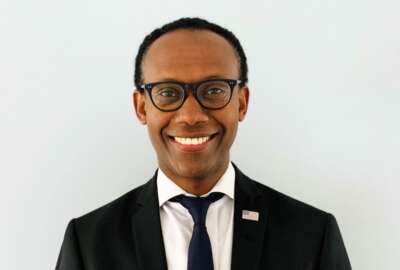
NASA scientist named Sammies finalist for polar ice research
Scientists have followed melting polar ice for decades. The gold standard for this research was pioneered by NASA scientist Claire Parkinson.
Best listening experience is on Chrome, Firefox or Safari. Subscribe to Federal Drive’s daily audio interviews on Apple Podcasts or PodcastOne.
Melting polar ice is a phenomenon scientists have been following for decades. What colleagues call the gold standard for this type of research was pioneered by a NASA scientist, Claire Parkinson. She has many publications to her credit, and now she’s a finalist in this year’s Service to America Medals program. To get her story, Federal News Network’s Eric White spoke to the climate change senior scientist from Goddard Space Flight Center on Federal Drive with Tom Temin.
Interview transcript:
Claire Parkinson: I have two main roles at NASA. One is as a scientist doing research on sea ice and climate change. And the other is as project scientist for an Earth observing satellite called Aqua. And those are very different roles. But they’re both really important to me. And it’s the Aqua Project Scientist role that is really a Service to America type role.
Eric White: What was involved in those projects?
Claire Parkinson: In that case, I’m facilitating the work of hundreds of other scientists and helping to make possible a whole lot of practical applications that come from the Aqua data that are benefiting literally millions of people. It’s like the use of the Aqua data for weather forecasting, monitoring, forest fires and volcanic emissions, oil spills, dust, storm, sea ice, air quality, water quality, carbon dioxide increases — all sorts of things. So so that’s the role as project scientists to that mission. That is really a Service to America. The other role is my research, which is looking at sea ice from satellite data. And that has been a really good topic for me in terms of when I started at NASA, which was way back in the 1970s, almost no one was interested in sea ice, and satellites were pretty new at that time. So I got to be kind of on the front edge of using satellite data for sea ice studies. And since almost nobody was interested at that time, there wasn’t the intense media coverage or anything like that, so I could just do the research.
Eric White: And so those results were and data was gathered through the use of passive satellites, is that the same with the Aqua data that was used whether it was microwaves emitted from the Earth, or was there another technique for the Aqua data?
Claire Parkinson: In both cases, it’s passive data. So it’s different instruments, but it’s passive data. So in other words, we are not sending a signal down to the earth and receiving it back like a radar would or our laser altimeter would show. Instead, the satellite is just passively collecting the information coming up from the Earth system. And in the case of the sea ice data, I’m looking at passive microwave data. And microwaves have been really valuable to us in looking at sea ice. And the reason being, if you have a satellite that’s taking pictures, invisible radiation, the type of radiation that our eyes see, then it gets great pictures, but it’s got all the limitations that our eyes have. So if there’s like a cloud in the way between the surface and the satellite, the satellites going to see the cloud. Now with microwave data, if you pick the right wavelength of the microwave, that problem goes away because the microwaves can go straight through the cloud.
Eric White: I wanted to ask also, day to day do you find yourself doing more data analysis or are you also involved with looking for more ways to gather data such as other methods for using the passive satellite systems?
Claire Parkinson: This varies from day to day and month to month and year to year. It turns out this particular year, 2020, my time has been pretty dominated by the Aqua role. But other years it tends to be more equal between my research and Aqua. Some years, it’s more on the research. So it definitely depends on the day and the year as to where my responsibilities are. So my top responsibility is Aqua. If there’s an issue with Aqua, that’s what I’ll deal with. But a lot of times there are not issues with Auqa and so therefore I can be doing my own research.
Eric White: As far as all the results go finding the decay of sea ice or the increased amount of forest fires., what are sort of your takeaways from the results that you’ve seen? Or do you see that not as your role, your role is specifically just for providing the data and that’s it?
Claire Parkinson: In terms of the sea ice, definitely I and my colleagues have been generating the results and so we have been analyzing them. So in the case of the Arctic sea ice data, we definitely determined this decrease in Arctic sea ice and we published a paper in 1999. I was the lead author, but there were co authors on it also. And it showed this clear decrease in Arctic sea ice, and we’ve kept up with that ever since then. And not only has the decrease been confirmed, but it’s been increased since then, in terms of a bigger decrease in the Antarctic, and I use the same data source, the same satellite data for the Antarctic sea ice research as for the Arctic sea ice research. In the Antarctic, the situation has been really different. In the Antarctic until 2014, the Antarctic sea ice was increasing overall. And so that was out of line with what people expected with global warming. And so that has generated a lot of interest in terms of why would it be increasing. Well, as turns out since 2014, it has increased significantly. So, my role there as a NASA scientist is to analyze the data, get the best possible data product I can get, and make it available to publications, and through sending the data to data centers, make it available to the public with the best analysis I can give as to what’s happening to the sea ice.
Eric White: You’ve had a long career at NASA so you must enjoy your work. What about it has been the best part for you?
Claire Parkinson: For me it’s been just an incredible privilege to get to work at NASA for the past 42 years. And every job has complications and difficulties in it — but it is just such an honor to be able to be working at NASA and such a privilege to get to be helping out in in areas that I know are serving other people, like in the project scientist role. So that has been just a huge privilege for me, and there are lots of other people involved in all aspects, and certainly I appreciate all of them also.
Read more about Claire’s work here.
Copyright © 2025 Federal News Network. All rights reserved. This website is not intended for users located within the European Economic Area.
Tom Temin is host of the Federal Drive and has been providing insight on federal technology and management issues for more than 30 years.
Follow @tteminWFED





